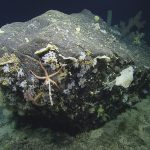Anegada Passage Cruise on the R/V Nautilus
September 3-13, 2014
ROVs Hercules and ARGUS




Led by U.S. Geological Survey scientists, the Anegada cruise explored the virtually unknown seamounts of the Anegada Passage, found in the eastern Caribbean. Throughout the expedition, scientists completed seven remotely operated (ROV) dives on three seamounts to collect 174 geological, biological, and chemical samples and obtain 2,773 square kilometers of multi-beam bathymetry data.
Deep-sea communities have been exposed to increasing amounts of anthropogenic impacts, and since seamounts have many connections to other marine ecosystems, any disturbance will have expansive repercussions. The ability to assess the resilience and sensitivity of an ecosystem is contingent upon understanding species distribution, abundance, and life history information. The samples collected during the cruise will be used to confirm the identity of the fauna observed on the dives and to begin age analysis of the octocorals found in the region. The extensive high-resolution mapping data obtained from the cruise has suggested a reinterpretation of the seafloor morphology, as the shape, size, and connections between the five seamounts have been fully realized.
Images courtesy of the Ocean Exploration Trust.
